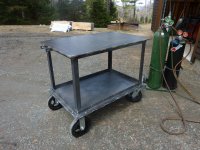Mark @ Everlast
Advertiser
Please, don't use coat hangers for Oxy Fuel welding. Coat hangers are made out of mystery metals. You can't rely on them. In fact they do actually make gas welding rods. RG is the designation used for gas filler metal. They look just like TIG rod/wire. You typically have RG 60 or RG 45 wire. I'm teaching this discipline for the tech college this semester. It's not expensive for a few pounds of it, and in my opinion, it ought to be LAW that every welder start with this process before advancing to other aspects of welding. It teaches so much about puddle recognition, manipulation and technique and develops skills which cross over to other areas of welding. Plus it can be used anywhere you can't get power to.
The Oxy-fuel brazing process in my opinion is underutilized. A lot is going toward MIG brazing these days, especially with the new vehicles with new alloys that just can't be welded. There also seems to be some interest in TIG brazing, but I think you just don't get as good of a job TIG due to the way it heats. AirGas just sent me (free) about 50 pounds of bare brass rods they had deleted from inventory because it did not have the proper "plastic" container. I'm teaching that after the welding aspect. The school purchased brazing flux to go along with it. The area director wanted me to order brass with "pre fluxed" coating. I do not like those type because they are expensive and they do not last in humid conditions. They are messy as well. The only thing I am not familiar with is the new Radnor flux. It's some sort of paste type flux. I am used to using dry boron type flux and heating the rod and dipping into the flux to secure some a few inches on the rod. It shouldn't be too hard to adapt, but that paste flux seems messy to me. But as for applications of brazing, I've used it many times in making two dissimilar hydraulic fittings "mate" together, when it would take a long time to get the part or was too expensive, or even discontinued. I've brazed up steel hydraulic lines, fittings to tanks, used it to fill holes where it wasn't critical to strength, brazed up engine blocks, flanges, ears and other things cast iron...all with oxy acetylene.
The Oxy-fuel brazing process in my opinion is underutilized. A lot is going toward MIG brazing these days, especially with the new vehicles with new alloys that just can't be welded. There also seems to be some interest in TIG brazing, but I think you just don't get as good of a job TIG due to the way it heats. AirGas just sent me (free) about 50 pounds of bare brass rods they had deleted from inventory because it did not have the proper "plastic" container. I'm teaching that after the welding aspect. The school purchased brazing flux to go along with it. The area director wanted me to order brass with "pre fluxed" coating. I do not like those type because they are expensive and they do not last in humid conditions. They are messy as well. The only thing I am not familiar with is the new Radnor flux. It's some sort of paste type flux. I am used to using dry boron type flux and heating the rod and dipping into the flux to secure some a few inches on the rod. It shouldn't be too hard to adapt, but that paste flux seems messy to me. But as for applications of brazing, I've used it many times in making two dissimilar hydraulic fittings "mate" together, when it would take a long time to get the part or was too expensive, or even discontinued. I've brazed up steel hydraulic lines, fittings to tanks, used it to fill holes where it wasn't critical to strength, brazed up engine blocks, flanges, ears and other things cast iron...all with oxy acetylene.
